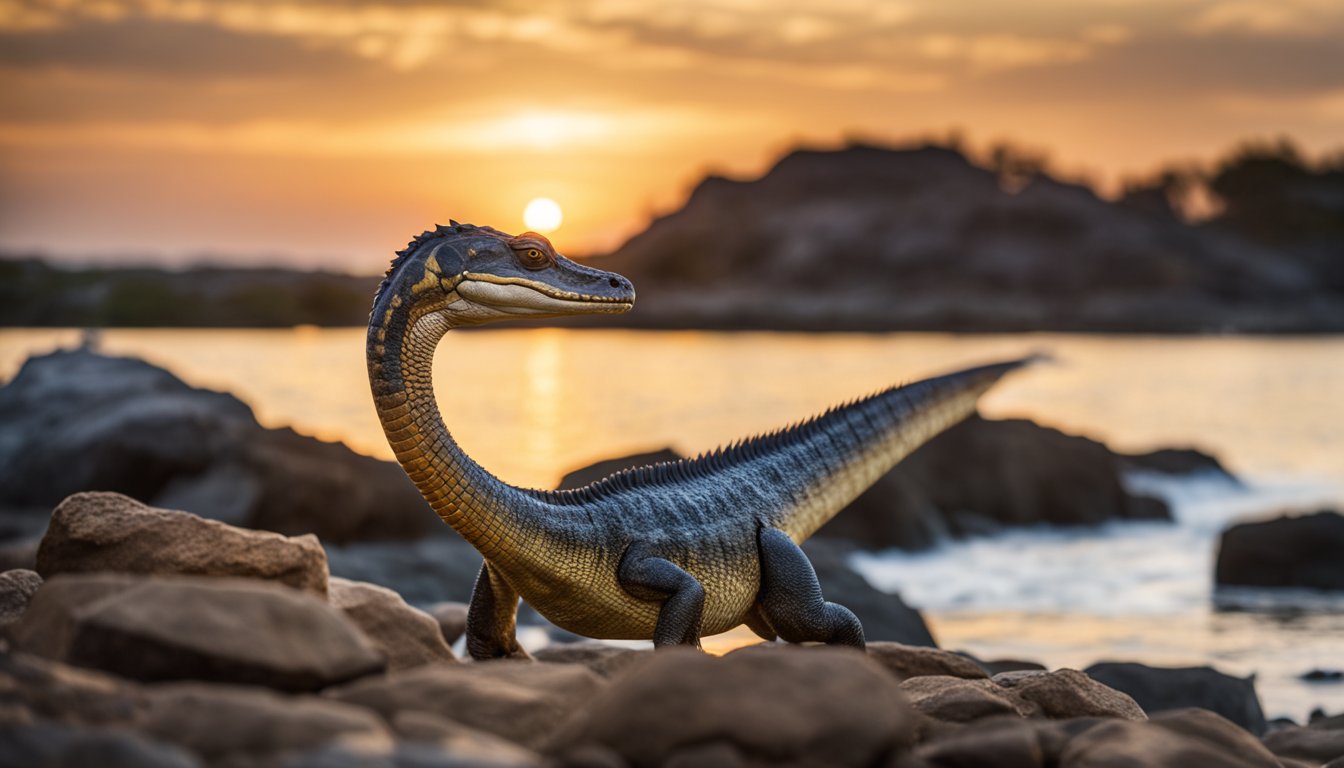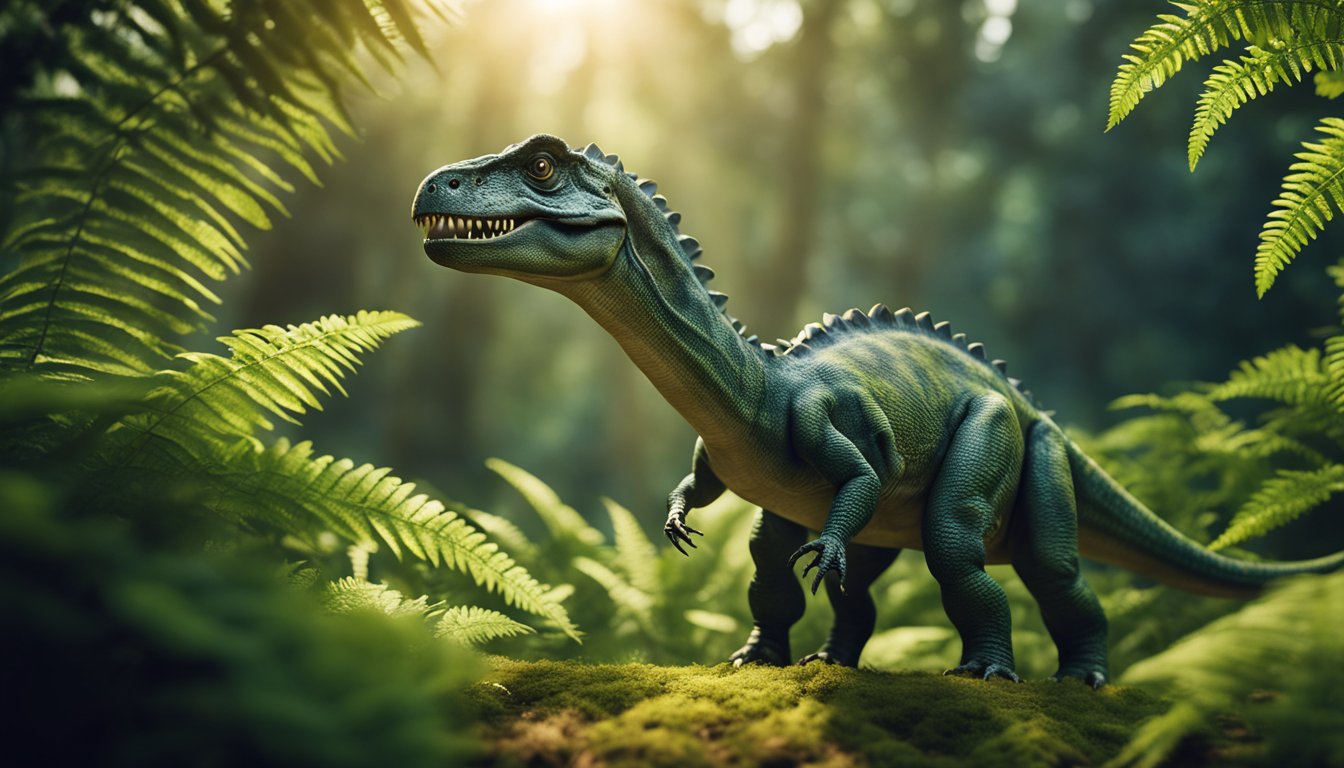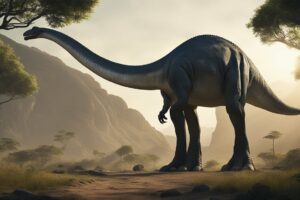Tanystropheus is a curious reptile that lived during the Triassic period, approximately 242 million years ago.
It is known for its incredibly long neck, which was almost three times the length of its torso.
Despite its unusual appearance, Tanystropheus was a successful hunter and lived in water, where it adapted to its environment in surprising ways.

The long neck of Tanystropheus has puzzled scientists for decades. How did it use its neck? Was it an advantage or a disadvantage?
Recent research has shed light on these questions, revealing that the long neck was actually an evolutionary adaptation that allowed Tanystropheus to catch prey more easily.
By elongating its neck, Tanystropheus could reach further and hunt in deeper water than other predators.
This gave it an advantage over its competitors and helped it survive in the tough Triassic environment.
Despite its impressive neck, Tanystropheus was a reptile like any other. It laid eggs, had scaly skin, and breathed air.
It is thought to have lived in coastal waters, where it hunted fish and other small prey.
Today, Tanystropheus is a fascinating example of the incredible diversity of life that has existed on Earth throughout its history.
Unraveling the Mystery of Tanystropheus
Fossil Discoveries and Significance
Tanystropheus was a peculiar creature that roamed the earth over 240 million years ago during the middle Triassic period.
The first fossils of Tanystropheus were discovered in the 1850s, and since then, paleontologists have been fascinated by this long-necked reptile.
The fossils of Tanystropheus have been found in Monte San Giorgio, a UNESCO World Heritage Site on the border between Switzerland and Italy.
The significance of Tanystropheus fossils lies in their anatomical peculiarities.
The most striking feature of Tanystropheus is its long neck, which was longer than its body and tail combined.
At first, scientists were unsure whether Tanystropheus lived on land or in the water.
However, recent studies have shown that Tanystropheus was a marine reptile that lived in the shallow waters of the ancient Tethys Ocean.
Anatomy of a Peculiar Creature
Tanystropheus had a long, slender neck that was made up of 12 vertebrae, each of which was elongated and flattened.
The neck was supported by elongated ribs that extended from the vertebrae.
Tanystropheus had a small head with a pointed snout and sharp teeth, which it used to catch fish and other small marine creatures.
The body of Tanystropheus was relatively small, measuring only about 2 meters in length.
The limbs were also small and weak, indicating that Tanystropheus was not well adapted for walking on land.
Instead, Tanystropheus used its long neck to reach up and catch prey in the water.
In conclusion, Tanystropheus was a fascinating creature that has puzzled paleontologists for over a century.
Its long neck and small body make it one of the most peculiar reptiles to have ever lived.
Thanks to recent discoveries, we now know that Tanystropheus was a marine reptile that lived in the shallow waters of the ancient Tethys Ocean.
Tanystropheus’ Lifestyle and Environment

Tanystropheus is a fascinating long-necked reptile that lived around 242 million years ago during the middle Triassic period.
This water-dwelling creature had an extraordinary neck that could grow up to three times the length of its body.
Scientists have long been fascinated by this ancient reptile and have been studying its lifestyle and environment.
Aquatic Hunter: Diet and Hunting Strategies
Recent studies have shed light on the diet and hunting strategies of Tanystropheus.
According to a study published in Current Biology, Tanystropheus had a diverse diet that included fish and squid.
The study also revealed that Tanystropheus was an ambush predator, waiting patiently for its prey before striking with lightning-fast speed.
Its long neck allowed it to reach out and grab prey that would otherwise be out of reach.
Habitats Through Time
Tanystropheus lived in a world very different from our own. During the middle Triassic period, the earth was a very different place.
The continents were still joined together in one giant landmass, and the climate was hot and dry.
However, there were also vast oceans and waterways that were home to a diverse array of marine life.
According to a recent study published in Phys.org, Tanystropheus was a water-dwelling creature that lived in the oceans and waterways of the Triassic period.
The study also revealed that Tanystropheus was not alone in the oceans and shared its habitat with other giant reptiles.
Overall, Tanystropheus was a fascinating creature that lived in a very different world from our own.
Its long neck and aquatic lifestyle make it a unique and intriguing subject for scientific study.
Scientific Breakthroughs and Technological Advances

CT Scans and 3D Imaging
Thanks to recent scientific breakthroughs and technological advances, researchers have been able to learn more about the long-necked reptile Tanystropheus than ever before.
One of the most significant developments has been the use of CT scans and 3D imaging to create detailed digital models of Tanystropheus fossils.
By using CT scanning and 3D imaging techniques, researchers have been able to create highly detailed models of the internal structures of Tanystropheus fossils.
This has allowed them to study the creature’s anatomy in much greater detail than was previously possible.
For example, researchers have been able to examine the creature’s respiratory system and determine that it had a unique air sac system that helped it breathe more efficiently.
Understanding Growth and Aging
Another area where scientific breakthroughs have been made in the study of Tanystropheus is in the understanding of its growth and aging.
By examining the growth rings in the bones of Tanystropheus fossils, researchers have been able to determine that the creature grew rapidly in its early years and then slowed down as it aged.
Using synchrotron radiation micro-computed tomography, researchers have also been able to study the microscopic structure of the bones of Tanystropheus fossils.
This has allowed them to determine that the creature’s bones grew in a way that was similar to that of modern reptiles, with layers of bone forming around blood vessels.
Overall, these scientific breakthroughs and technological advances have allowed researchers to learn more about the long-necked reptile Tanystropheus than ever before.
By using CT scans and 3D imaging to create detailed digital models of Tanystropheus fossils, and by examining the growth rings and microscopic structure of its bones, researchers have been able to gain new insights into the anatomy, growth, and aging of this fascinating creature.
The Legacy of Tanystropheus in Paleontology

Species Classification and Evolutionary Insights
Tanystropheus is a genus of long-necked reptiles that lived during the Middle Triassic period, approximately 242 million years ago.
The first Tanystropheus fossil was discovered in 1852 in Switzerland, and since then, many more fossils have been found all over the world.
Scientists have classified Tanystropheus as a member of the family Tanystropheidae, which includes other long-necked reptiles such as Macrocnemus and Langobardisaurus.
However, the exact classification of Tanystropheus has been a topic of debate among paleontologists for many years.
Recent studies have shed new light on the evolutionary relationships of Tanystropheus.
For example, a 2020 study published in Current Biology suggests that small and large specimens of Tanystropheus represent separate species with different diets, indicating niche partitioning.
Additionally, the study suggests that Tanystropheus had several adaptations for an aquatic lifestyle, such as a streamlined body and paddle-like limbs.
Tanystropheus in Popular Culture and Education
Tanystropheus has captured the imagination of people worldwide, and it has been featured in various forms of popular culture, including books, TV shows, and movies.
For example, Tanystropheus was featured in the BBC documentary series Walking with Dinosaurs, where it was depicted as a giant, long-necked reptile that lived in the ocean.
In addition to its popularity in popular culture, Tanystropheus has also had a significant impact on education and scientific research.
For example, the National Museums Scotland has several Tanystropheus fossils in its collection, which are used to teach visitors about the evolution of life on Earth.
Overall, Tanystropheus is a fascinating creature that has contributed significantly to our understanding of the evolution of long-necked reptiles.
Its legacy in paleontology, popular culture, and education continues to inspire new generations of scientists and nature enthusiasts.
Frequently Asked Questions

How big was the Tanystropheus compared to other reptiles of its time?
The Tanystropheus was a giant reptile that lived around 242 million years ago, during the Triassic period.
It was one of the largest creatures of its time, measuring up to 20 feet long.
Its long neck made up about half of its total length, and it had a small head and a long tail.
What could be the reasons behind the Tanystropheus’s distinctive long neck?
The reason behind the Tanystropheus’s long neck is still a mystery to scientists.
Some believe that it used its long neck to catch fish or other prey in the water, while others think that it used it to reach vegetation on land.
Another theory is that it used its neck to attract mates or to intimidate rivals.
Which period in history did the Tanystropheus inhabit, and what fossils tell us about it?
The Tanystropheus lived during the Triassic period, which was about 252 million to 201 million years ago.
Fossils of the Tanystropheus have been found in places like Switzerland, Italy, and China.
Scientists have studied these fossils to learn more about the Tanystropheus and its behavior.
How does the Tanystropheus differ from dinosaurs and other prehistoric creatures?
The Tanystropheus was not a dinosaur, but rather a reptile that lived during the same time period as the dinosaurs.
Unlike the dinosaurs, the Tanystropheus had a long neck and a small head.
It also had fewer vertebrae in its neck than other long-necked animals like giraffes.
What kind of habitat did the Tanystropheus live in during its existence?
The Tanystropheus was a marine reptile that lived in the water.
It had paddle-like limbs that helped it swim, and it likely hunted for fish and other prey in the water.
However, it is also possible that it spent some time on land, where it may have fed on vegetation.
Can we find any descendants of the Tanystropheus in today’s animal kingdom?
There are no known descendants of the Tanystropheus in today’s animal kingdom.
However, its long neck has inspired scientists to study other long-necked animals like giraffes and sauropod dinosaurs.
By studying these animals, scientists hope to learn more about the evolution of the long neck and how it has helped animals adapt to different environments over time.






